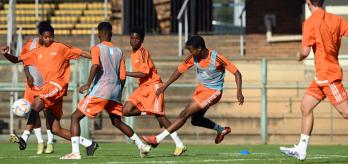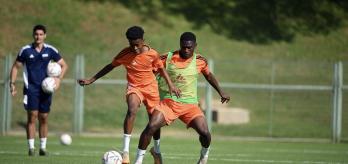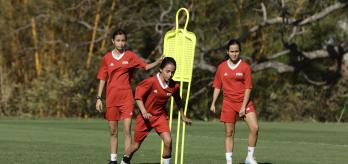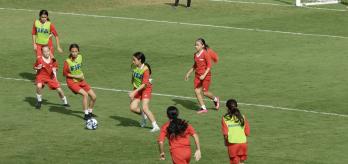Methodology
What is practised?
This possession game works on the coordination and defensive movements of a four-player defensive unit that is pressing to regain possession. The members of the unit are tasked with recognising each other’s pressing actions and positioning, as well as the distance to the opponent and the ball. If a defender steps out to press, the other members of the unit must react and jump out to close off possible passing options and spaces that may open up. Occupying spaces between two opponents and close to the first pressing player enables the unit to keep a good defensive structure that prevents the opposition from picking out passes or playing through them. In order to defend successfully, the unit must stay compact. Once possession is won, the unit must transition quickly and use width and good positioning in tight spaces.
For whom is this relevant?
This exercise revolves around the unit scale, focusing on its ability to adopt and maintain an optimal pressing structure with coordinated movements between four players. The drill is particularly relevant to teams that implement an aggressive press in an effort to win the ball back immediately. The scenario can be applied to situations in which the opposition build up from the goalkeeper and use triangular passing angles to progress play. The exercise is non-position-specific, although defending players are asked to behave like they are part of the front pressing units by preventing the ball from progressing.
How is the practice designed?
This exercise involves an opposed possession game that aims to improve a unit’s press against the opposition’s build-up or ball progression. The drill gives the unit the opportunity to work on their actions and coordination as a small group. The goalkeepers positioned at either end of the exercise area provide an element of direction, although players do not always need to play forwards. The narrow, reduced-sized exercise area helps players to understand their pressing structure within a space that could replicate a channel on the pitch. The limited space ensures that the pressing team are able to focus on staying close together in one area of the pitch and keeping the opposition in that area.
Session plan
Organisation
-
Mark out a 30m x 15m exercise area using cones.
-
Place a goalkeeper, who acts as a neutral player, at either end of the exercise area.
-
Split the group into 3 teams: 2 teams of 4 (oranges and blues) and a team of 2 (greys), who also act as neutral players.
-
Set up a scenario featuring 4v4 (oranges v. blues), plus 2 neutral outfield players, inside the exercise area.
Explanation
-
The exercise starts with the third coach (C3) playing a pass into one of the goalkeepers.
-
The goalkeeper controls the ball before picking out an orange-team player.
-
The oranges aim to keep possession, with the support of the 4 neutral players (2 greys and the 2 goalkeepers), and switch possession to the goalkeeper at the opposite end of the exercise area.
-
The blues try to win the ball back.
-
If the blues gain possession, the teams switch roles immediately.
-
If the ball goes out of play, play restarts with C3 playing a pass to a goalkeeper.
Key coaching points
Roles of the coaches
-
First coach: leads the session and intervenes at intervals to coach the players.
-
Second coach: offers the players encouragement from their position at one end of the exercise area.
-
Third coach: offers the players pointers and feeds balls into the exercise area from their position on one side of it.























